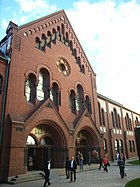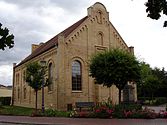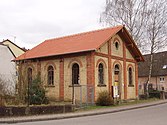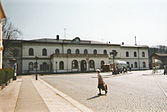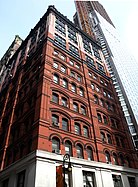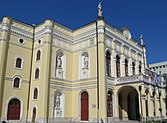Rundbogenstil





Rundbogenstil (round-arch style) is a nineteenth-century historic
History and description
The style was the deliberate creation of German architects seeking a German national style of architecture, particularly
Rundbogenstil was employed for a number of railway stations, including those in
Rundbogenstil was also widely employed in
Rundbogenstil architecture was influential in England, with Alfred Waterhouse's buildings for what is now called the Natural History Museum (originally the British Museum Natural History Collection) in London showing a direct and self-conscious emulation of the style.[6][dubious ]
Rundbogenstil German synagogues
-
Berlin Lindenstrasse (1890–91)
-
Berlin Rykestrasse (1904)
-
Deidesheim (1854)
-
Ermreuth
-
Freiburg (1870)
-
Friedrichstadt (1845)
-
Hechingen (1850–52; facade 1881)
-
Kassel (1839)
-
Kraków am See (1866)
-
Laufersweiler (1839)
-
Meisenheim (1866)
-
Steinsfurt (1893)
Rundbogenstil German train stations
-
Crimmitschau (1873)
-
Hersfeld (1883)
-
Minden(1847)
-
Munich(1849)
Rundbogenstil architecture in New York City
-
Morse Building on Nassau Street, Manhattan (1878–80)
-
19th Precinct, 153 East 67th Street, Manhattan
-
South Congregational Church, Carroll Gardens, Brooklyn(1857)
-
Paul Robeson Theater, formerly the FourthUniversalist Church, Fort Greene, Brooklyn (1833–34)
-
French Evangelical Church, formerly the Catholic Apostolic Church, 126 West 16th Street, Manhattan (c.1865)
-
First Reformed Church, rebuilt 1859, Jamaica, Queens
Rundbogenstil architecture in Hungary
Rundbogenstil-influenced architecture in England
Rundbogenstil in Belgium
The Rundbogenstil was also widely employed in Belgium, for public buildings as well as for churches. A keen promotor of Neoclassiscism and the Rundbogenstil in Belgium was architect Lodewijk Roelandt (1786-1864), who lived in the city of Ghent. Among his achievements in Rundbogenstil are St Anne's Church (Sint-Annakerk (Gent)), the riding school Arena Van Vletingen, both in Ghent, and the Onze-Lieve-Vrouw-van-Bijstand-der-Christenenkerk (Sint-Niklaas) at Sint-Niklaas.
See also
References
Notes
- ^ Strauss, Gerhard & Olbrich, Harald: "Eintrag Rundbogenstil." Lexikon der Kunst. Architektur, bildende Kunst, angewandte Kunst, Industrieformgestaltung, Kunsttheorie. (in German.) Leipzig: Seemann. Band 6, p. 293 ff.
- ^ Bergdoll, Barry, European Architecture, 1750-1890, Oxford, 2000, pp. 184-9
- ^ Kathleen Curran, The Romanesque Revival: Religion, Politics, and Transnational Exchange, Penn State Press, 2003, p. 1 ff.
- ^ James Stevens Curl, "Rundbogenstil", A Dictionary of Architecture and Landscape Architecture, 2000, Encyclopedia.com [1]
- ^ Rachel Wischnitzer, The Architecture of the European Synagogue, Philadelphia: JPS, 1964, pp. 197-8
- ^ Records of HM Office of Works, P.R.O., Works 17/16/2, National Archives, 4 March 1868.
External links
 Media related to Rundbogenstil architecture at Wikimedia Commons
Media related to Rundbogenstil architecture at Wikimedia Commons


